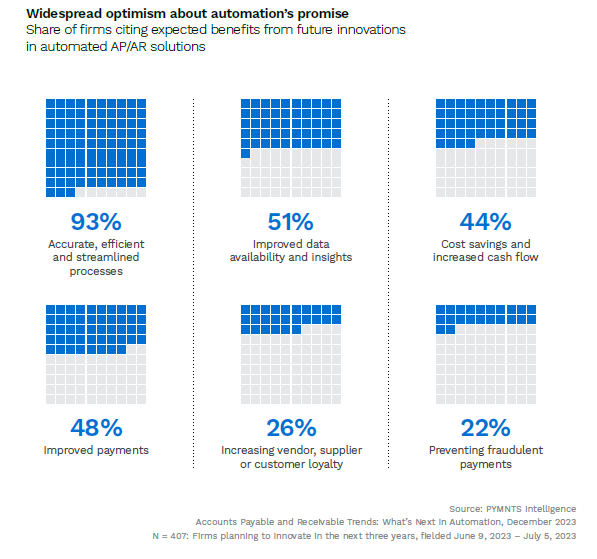
Ensuring vendor satisfaction is crucial for businesses as it directly impacts the overall success and efficiency of operations.
Satisfied vendors are more likely to maintain positive relationships with customers, deliver quality goods or services consistently, and collaborate effectively. This, in turn, fosters a stronger and more reliable supply chain, reducing the risk of disruptions and enhancing the company’s reputation.
A key strategy in achieving vendor satisfaction involves the automation of accounts payable (AP) and processes, a technology-driven approach proven to elevate satisfaction levels significantly.
In “Accounts Payable and Receivable Trends: What’s Next in Automation,” PYMNTS Intelligence leverages insights from a survey of over 400 executives to assess the investments that mid-sized businesses — those annually generating $3.5 million to $15 million in revenue — have made or plan to make to automate AP and AR processes and the benefits they can expect to derive from their financial commitments.
According to findings detailed in the study, full automation allows organizations to cut labor costs and reduce the occurrence of errors, enabling mid-sized firms to achieve greater accuracy and efficiency in process management compared to those with partial or no automation.
Moreover, automated systems process high volumes of transactions swiftly, leading to improved data availability and insights. This precision is particularly crucial in financial reporting and compliance, where inaccuracies can result in substantial issues, including regulatory penalties.
Against this backdrop, companies aiming to maximize the advantages of automation need to fully commit to the process. In fact, the distinction between fully automating AP processes and partial automation is stark, with over 70% of mid-sized firms attesting to heightened satisfaction after embracing full AP automation. In contrast, a mere 40% of those employing partial automation report similar positive outcomes.
This significant boost in satisfaction can potentially result in better terms and conditions for business transactions, creating an environment where companies with fully automated processes may negotiate more favorable agreements with their vendors.
One of the firms embracing this trend is business-to-business (B2B) payments platform Melio, which recently added real-time payments to its suite of offerings. The feature allows payors to instantly send funds to vendors, enabling businesses to hold funds for an extended period, and eliminating the need to make payments days in advance of an invoice’s due date to ensure timely delivery, PYMNTS reported last month.
“While consumers have taken advantage of real-time payments for years, vendors and their small business customers are now able to reap the benefits of this innovative technology,” Melio CEO and Co-Founder Matan Bar said in a Dec. 13 release, adding that “real-time payments are a game-changer for small businesses […].”
According to the report, mid-sized firms strategically prioritize the automation of certain payment types, mainly payments of regular amounts and those occurring at regular intervals. This deliberate emphasis on consistency and predictability in financial transactions is designed to increase operational efficiency while mitigating the risks associated with error-prone tasks.
Additionally, the report emphasizes the evident link between automation and business growth. Firms that do not automate any processes expect less growth compared to those embracing automation. Full AP automation can also act as a catalyst for scaling business operations and improving financial management, leading to cost savings and increased cash flow for firms.
It’s no surprise then that mid-sized firms planning to automate further in the next three years have high hopes, with over 90% expecting to see accurate, efficient and streamlined processes and more than half expecting improved data availability and insights.
In essence, going all-in and fully automating AP and AR processes automation is more than just a shift in operational dynamics. It goes beyond boosting vendor satisfaction and making financial processes smoother; it’s a recognition by mid-sized firms that in the evolving business landscape, being innovative and adaptable is key to long-term success.
